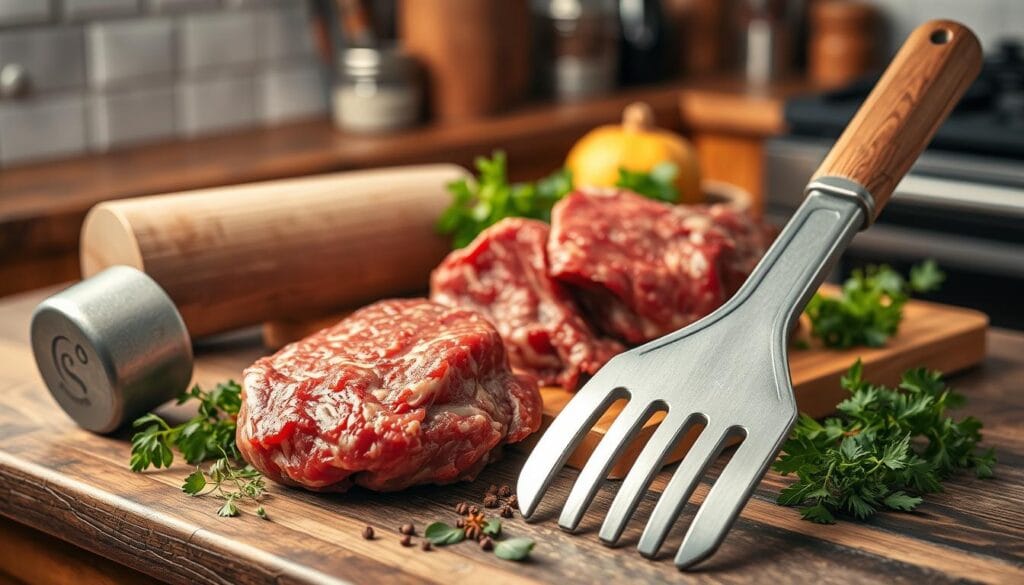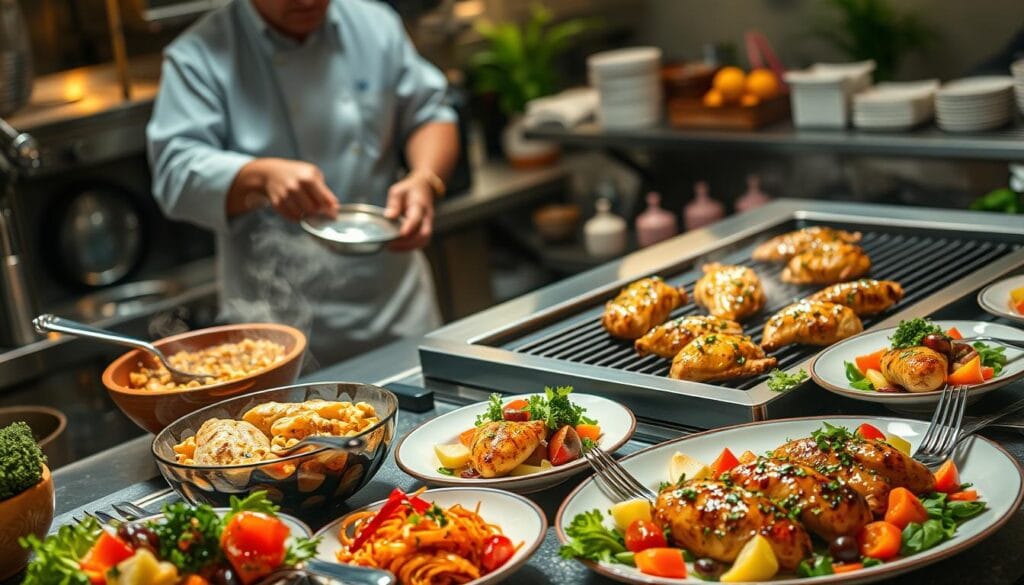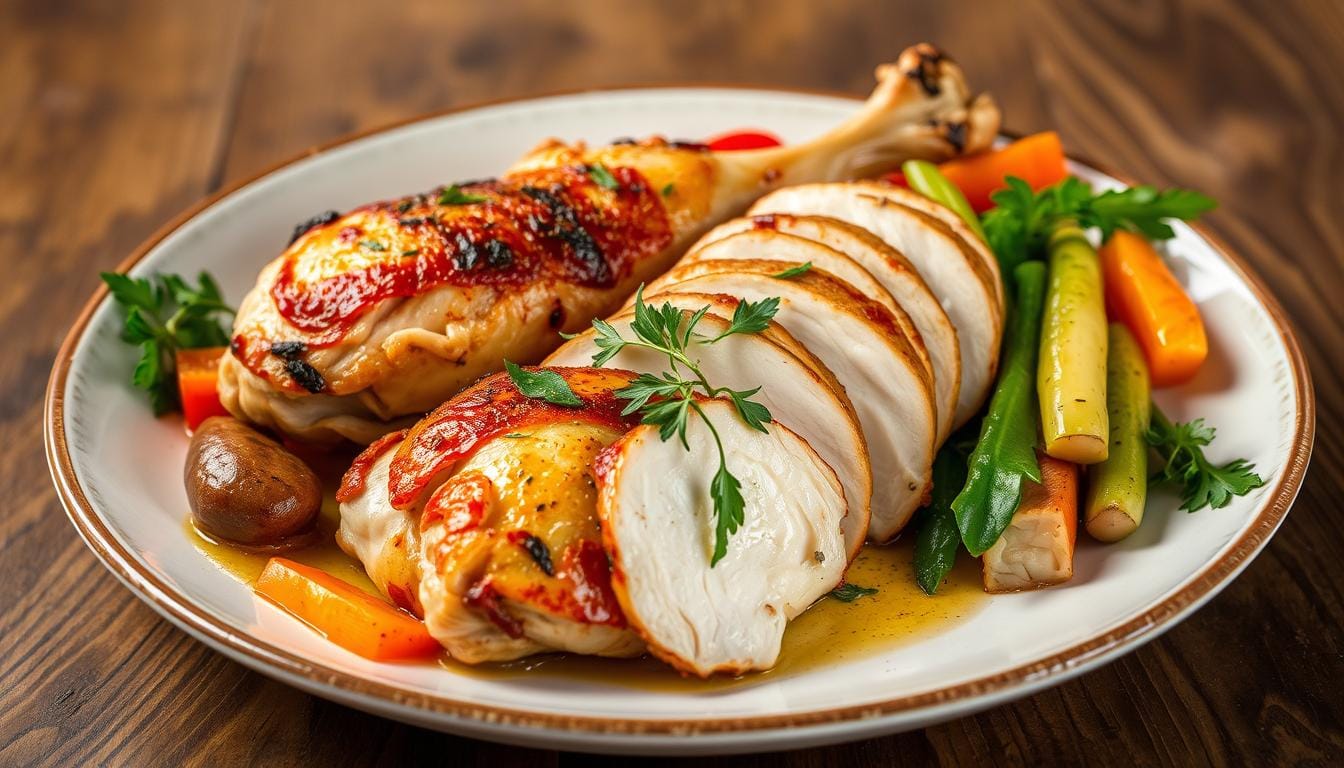I love chicken, and I’ve always wanted to know how to make chicken soft like restaurants—the kind that melts in your mouth. After years of experimenting, I finally discovered the secrets.
In this guide, I’ll show you professional techniques to achieve tender, juicy chicken at home. You’ll learn about brining, marinating, and cooking methods to make chicken breasts and drumsticks taste like they’re straight from a restaurant kitchen.
The Science Behind Restaurant-Style Tender Chicken
To make chicken as tender as in restaurants, you need to know the cooking science. It’s all about how chicken proteins react to heat and keeping moisture in.
Protein Denaturation Process
When chicken cooks, heat changes its proteins. This makes the chicken go from soft to firm. How much it changes affects its tenderness.
Impact of Heat on Chicken Texture
Too much heat can make chicken tough. This is because the proteins keep coagulating and push out moisture. Chicken breast, with less connective tissue, dries out easily if not cooked right.
Role of Moisture Retention
Keeping chicken moist is key to its tenderness. Using the right cooking methods and controlling temperature helps. It keeps the chicken juicy and soft.
| Cooking Technique | Impact on Chicken Texture |
|---|---|
| Quick Velveting | Tenderizes chicken by partially denaturing proteins and sealing in moisture |
| Brining | Adds moisture and enhances the chicken’s ability to retain juices during cooking |
| Slow Cooking | Gradually denatures proteins, resulting in a melt-in-your-mouth texture |
“The secret to the perfect tender chicken lies in understanding the delicate balance between protein denaturation and moisture retention.”
Essential Brining Techniques for Juicy Chicken
Unlock the secret to restaurant-quality chicken tenderness with the power of brining. Brining involves soaking your chicken in a simple saltwater solution. Use 1-3 tablespoons of salt per liter of water. This process helps your chicken stay moist and adds delicious flavor.
The recommended brining time for boneless, skinless chicken breasts is 30 minutes at room temperature or up to 1 hour in the fridge. For bone-in, skin-on chicken thighs, brine for 30-60 minutes. Try adding fragrant herbs like rosemary or tangy citrus like lemon juice for extra flavor.
Brining denatures the chicken’s proteins, making them hold onto moisture better during cooking. This results in succulent, juicy meat that’s hard to overcook. To avoid over-salting, follow the recommended brining time and don’t salt the chicken again before cooking.
- Prepare the brine by dissolving 1/4 cup of kosher salt and 1/4 cup of sugar (optional) in 1 quart of water.
- Add 1-2 cloves of garlic, a teaspoon of black peppercorns, 2-3 bay leaves, and your choice of fresh herbs like rosemary or thyme.
- Submerge the chicken in the brine and refrigerate for 30 minutes to 4 hours, depending on the cut.
- Rinse the brined chicken under cold water before cooking to remove any excess salt.
Brining is a game-changer for achieving tender, flavorful chicken every time. By mastering this essential technique, you’ll bring restaurant-quality results to your home kitchen. Experiment with different flavor combinations and brine durations to find your perfect chicken-tenderizing formula.
“Brining is the secret to the most juicy and tender chicken you’ll ever make at home.”
Professional Marinades That Transform Chicken Texture
Getting chicken to taste like it’s from a fancy restaurant is all about the marinade. Chefs use special ingredients to make the meat tender and flavorful. Let’s look at what makes chicken truly special.
Acid-Based Marinades
Acids like vinegar, citrus, and wine are key in marinades. They break down tough chicken tissues, making it tender and juicy. The acidity also softens the meat, making it easier to chew.
Enzyme-Rich Ingredients
Fruits and veggies with enzymes can tenderize chicken even more. Pineapple, papaya, and kiwi are great for this. They break down chicken’s protein, making it incredibly soft.
Oil-Based Solutions
Oils are important for keeping chicken moist and flavorful. Olive, avocado, and vegetable oils are great for this. They help your chicken stay juicy and full of flavor.
By mixing acids, enzymes, and oils, you can make amazing chicken at home. Try different combinations to find what you like best.
“The key to tender, juicy chicken lies in the marinade. By harnessing the power of acids, enzymes, and oils, you can unlock the secret to restaurant-quality texture right in your own kitchen.”
How to Make Chicken Soft Like Restaurants?
Making chicken soft like restaurants at home is a challenge. But, with the right methods, you can get that tender texture. The secret is in preparation, temperature control, and letting it rest after cooking.
Brining or marinating chicken is a great way to tenderize it. Soaking the chicken in saltwater or a flavorful mix with acids like yogurt or lemon juice softens it. It also adds delicious flavors.
Controlling the temperature is key. Cooking chicken low and slow, like sous vide or slow roasting, breaks down tissues. This makes the chicken tender and juicy. Make sure it reaches 165°F (75°C) for safety and juiciness.
Letting the chicken rest for 5-10 minutes before serving is crucial. It lets the juices spread evenly, making each bite full of flavor. By following these steps, your chicken will be as tender as in a restaurant.
The secret to soft chicken like restaurants is smart preparation, precise temperature, and resting. With practice, you can make your chicken as tender as in a restaurant.
Temperature Control Secrets for Perfect Tenderness
To get chicken as tender as restaurant-quality, you need to control the temperature carefully. The secret is in low and slow cooking, checking the internal temperature, and letting it rest. These steps are crucial for tender and juicy chicken.
Low and Slow Cooking Method
Cooking chicken at 122°C (250°F) for a long time keeps it moist and tender. This method breaks down the proteins, making the chicken soft. It also cooks evenly, so the outside doesn’t get too hard while the inside stays juicy.
Ideal Internal Temperature Guide
The chicken is perfectly cooked at 75°C (165°F). This temperature kills off bad bacteria and keeps the meat juicy. A digital food thermometer is key to checking the temperature and avoiding overcooking.
Resting Period Importance
Letting the chicken rest for 5-10 minutes is essential. This allows the juices to spread evenly, making the chicken moist and flavorful. Without this step, the chicken can end up dry and tasteless.
By following these temperature control tips, you can make chicken as tender as restaurant-quality. It takes patience and attention to detail to get it right every time.
Expert Tools and Equipment for Tender Chicken
Preparing perfect chicken is all about the right tools. From meat tenderizers to thermometers, these items ensure your chicken is soft and juicy. They help you achieve that restaurant-quality texture you love.
A good meat mallet or tenderizer is key. The Williams Sonoma Reversible Meat Tenderizer is a top choice for its durability. It’s nearly 2 pounds and has a 3-inch diameter surface area. The OXO Good Grips Die Cast Meat Tenderizer is a budget-friendly option with a compact design.
The Rösle’s Meat Hammer is the best mallet for tenderizing. It’s made of stainless steel and has a textured side for piercing. The flat side helps flatten the meat for even cooking. The JY Cookment’s blade-style meat tenderizer uses stainless steel needles to cut through muscle fibers, making the chicken tender faster.
| Tool | Key Features | Weight | Dimensions |
|---|---|---|---|
| Williams Sonoma Reversible Meat Tenderizer | Durable, efficient | Nearly 2 lbs | 3 inches diameter, 6 inches tall x 3 inches wide |
| OXO Good Grips Die Cast Meat Tenderizer | Budget-friendly, die-cast aluminum | 8.8 oz | 1.85 x 2.4 x 9.75 inches |
| Rösle’s Meat Hammer | Textured for piercing, flat for flattening | 14.8 oz | 11.02 x 1.97 x 2.28 inches |
| JY Cookment’s Blade-Style Meat Tenderizer | Stainless steel needles, efficient tenderizing | 10.4 oz | 6.3 x 0.3 x 5.9 inches |
A meat thermometer is crucial for ensuring your chicken is cooked to 165°F (74°C). This ensures tenderness and food safety. A heavy-bottomed skillet or cast-iron pan helps distribute heat evenly. Using a lid or aluminum foil traps moisture for juicier chicken.

With the right tools and a bit of practice, you can make restaurant-quality chicken at home. Try different tenderizing techniques and equipment to find what works best for you.
Common Mistakes That Lead to Tough Chicken
Learning how to make chicken soft like restaurants starts with understanding and avoiding common mistakes. These errors can lead to dry, tough chicken, but with the right approach, you can achieve tender and juicy results at home.
Overcooking Issues
One major reason chicken isn’t as soft as in restaurants is overcooking. High heat for too long makes the proteins tighten and lose moisture, leaving the chicken tough and flavorless. To master how to make chicken soft, avoid overcooking by using an oven at 375–400°F and monitoring internal temperatures.
Temperature Fluctuations
Uneven cooking temperatures can also ruin the texture of your chicken. For instance, when frying, start with oil at 360°F and maintain a steady temperature between 300–325°F. Consistency is key to achieving that restaurant-quality softness.
Improper Preparation Methods
Preparation is crucial in learning how to make chicken tender and juicy like restaurants. Skipping brining or marinating leads to dry chicken. Brining for up to eight hours locks in moisture, while marinating with acidic ingredients for 2–4 hours softens the meat. Don’t forget to let the chicken rest after cooking to keep the juices inside.
By understanding and correcting these common mistakes, you’ll discover how to make chicken soft like restaurants every time you cook at home. Focus on preparation, temperature control, and proper resting to achieve perfect results.
Restaurant-Style Chicken Cooking Methods
Many home cooks wonder how to make chicken soft like restaurants, achieving that tender and juicy texture we all love. Luckily, there are several professional methods to replicate restaurant-quality chicken in your kitchen.
One popular method is sous vide cooking, a foolproof way to make chicken soft and moist. By sealing chicken in a bag and cooking it in a water bath at 60°C (140°F) for about an hour, you can achieve perfectly tender results. A quick sear after sous vide adds a golden crust without compromising the soft texture.
Professional chefs also know how to make chicken soft like restaurants by using low-temperature oven cooking followed by a quick pan-sear. Roasting chicken at 135°C (275°F) tenderizes it slowly, while a final sear ensures even browning and locks in juices.
Another effective method is poaching chicken in a flavorful broth. This gentle cooking technique keeps the chicken moist and tender. Adding herbs, spices, or acidic ingredients like lemon or wine enhances both the flavor and texture, making it perfect for anyone seeking to master how to make chicken soft like restaurants.
| Cooking Method | Temperature | Time | Key Benefits |
|---|---|---|---|
| Sous Vide | 60°C (140°F) | 1 hour | Tender, juicy texture |
| Low-Temp Oven + Pan-Sear | 135°C (275°F) | Varies | Gentle tenderization, even browning |
| Poaching in Broth/Liquid | Simmering | Varies | Moist, flavorful chicken |
Learning these restaurant-style chicken cooking methods can make your home-cooked meals much better. You’ll enjoy the taste of fine dining in your own kitchen.

Essential Steps for Even Cooking and Moisture Retention
Getting your chicken dishes just right can be tricky, especially if you’re trying to learn how to make chicken soft like restaurants. But with a few easy steps, you can achieve that tender, juicy texture at home. One important technique is to ensure the chicken cooks evenly, which is crucial for restaurant-quality results.
Start by pounding chicken breasts to an even thickness. This helps the heat spread uniformly and prevents the chicken from drying out or cooking unevenly—key steps in mastering how to make chicken tender and juicy like the pros.
Another critical step in achieving restaurant-style tender chicken is covering the chicken with foil during cooking. This locks in moisture and keeps the chicken juicy. For added tenderness, pour a little water, white wine, or chicken stock into the pan before covering it.
By following these techniques, you’ll master how to make chicken soft like restaurants with consistent, professional results every time.
- Pound chicken breasts to an even ¼-inch thickness for uniform cooking
- Cover the chicken with foil during cooking to lock in moisture
- Add a splash of liquid (water, white wine, or chicken stock) to the pan before covering
Lastly, letting the chicken rest after cooking is very important. This lets the juices spread evenly throughout the meat. By following these steps, you’ll make moist, tender chicken that’s sure to impress.
“The key to perfectly cooked chicken is in the details. By taking the time to pound, cover, and rest the meat, you’ll unlock the secrets to restaurant-worthy tenderness.”
Conclusion
Making chicken as soft and tender as restaurants is possible with the right steps. Understanding how to denature proteins and keep moisture in is key. This way, you can make chicken that’s juicy and full of flavor, just like in your favorite places.
Brining and marinating are important to make the chicken tender and flavorful. Keeping the chicken at the right temperature, like low and slow cooking, helps it stay moist. Also, letting the chicken rest after cooking is crucial for keeping it tender and juicy.
With a bit of patience and practice, you can make chicken as tender as the pros. By following the tips in this article, you’ll be able to make chicken that everyone will love. Now, you can make perfect tender chicken breasts in your own kitchen.

